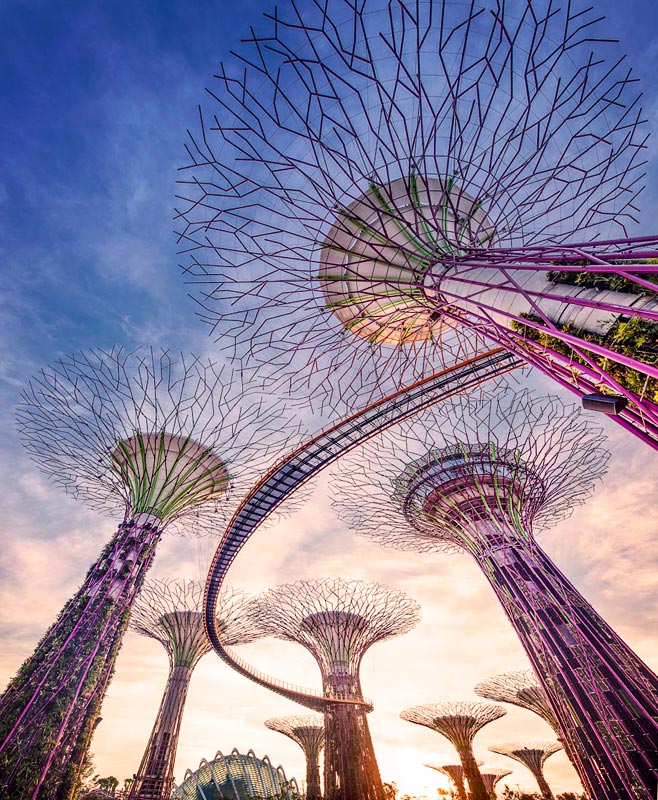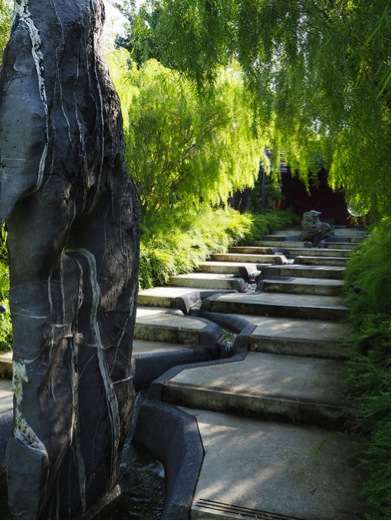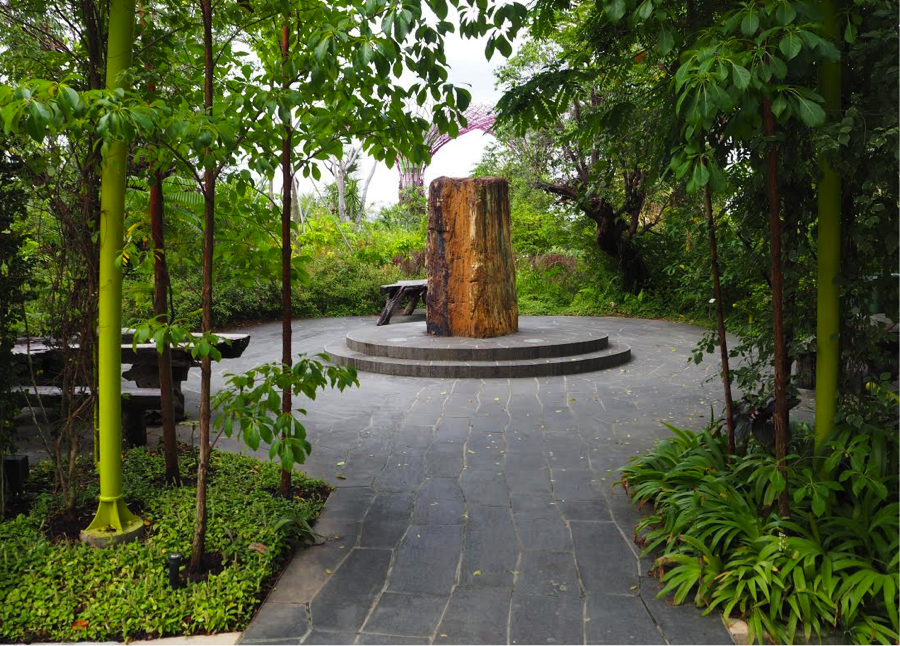In our Open Voices blog we share insight from leaders in our communities who are advancing what it means to have sacred, open green spaces in our cities. This week, we present an interview with Dr. Adrian Loo of Gardens by the Bay in Singapore.
Nature Sacred: In your role as Director of Research and Horticulture at Gardens by the Bay, what are your main tasks and projects?
Dr. Loo: Strategically, my team’s role is to inspire science within the gardens – amongst the staff and building up the capacity to use science to resolve horticultural problems. We have developed a research facility that includes a lab, tissue culture facilities and research conservatories. We are constantly building up our breeding capabilities and propagate interesting horticultural ornamentals such as orchids, begonias, bromeliads, gesnerids etc. A big part of the research also goes into soil science and aspects of plant physiology such as light levels, temperature and how flowering is affected by these. The department also does plant interpretation and we write catchy descriptions of plants that are interesting and at the same time botanically accurate in terms of their identity as species or cultivars and their ethnobotanical uses.
Nature Sacred: The Gardens by the Bay is in its first few years of operation. It covers a large area in Marina Bay and offers multiple diverse garden areas. Can you tell us about some of the most popular sites?
Dr. Loo: Since its official opening in June 2012, Gardens by the Bay has welcomed over 15 million visitors. The gardens, built right in the heart of Singapore’s new downtown and developed over reclaimed land, comprise three waterfront gardens, namely, Bay South, Bay East and Bay Central, altogether spanning 101 hectares. The 54-hectare Bay South is the largest of the three and currently the most developed with 2 cooled conservatories (a 1.2-hectare Flower Dome and the 0.8-hectare Cloud Forest) as well as 18 Supertrees that range from 25 to 50 metres in height. The Domes and the Supertrees are definitely a draw for our visitors.

NS: Tell us about the Supertrees!
Dr. Loo: The Supertrees have become iconic and synonymous with Gardens by the Bay! Amidst these Supertrees, a 128 metre walkway suspended at a height of 22 metres allows a panoramic view of the gardens, the waterfront and the city skyline. One of these supertrees conceals a tall chimney that filters flue from the incinerator burning horticultural waste that provides biomass energy to cool the air in the two domes. These Supertrees are vertical gardens clad in epiphytes, mainly bromeliads, orchids, ferns, hoyas and woody vines.
NS: Are there areas of the gardens that are smaller, enclosed sections?
Dr. Loo: Yes, the main gardens [are] designed based on two broad themes – “Plants and People” and “Plants and Planet”. Within these themes are sections of gardens that celebrate the world of plants and how inextricably linked humans are to the plant kingdom. Pertinent to our interview is perhaps the Heritage Gardens, which demonstrate how the different ethnic groups in Singapore have used plants as food, medicine and in religion and culture.
Plants and People – The Heritage Gardens and the Flower Dome
The Indian, Chinese, Malay and Colonial Gardens form the Heritage-themed gardens that show how plants play important cultural and economical roles in Singapore’s three main ethnic groups. Through carefully selected plants, they celebrate our multicultural society and plants of commerce that were introduced during the time when Singapore was one of the Straits Settlements. The Flower Dome displays plants from different parts of the world that enjoy a Mediterranean climate.
Plants and Planet – The World of Plants and The Cloud Forest
The Discovery, Web of Life, Fruits and Flowers, Understory, World of Palms and Secret Life of Trees celebrate botanical diversity through different assemblages of plants that showcase their form and function. The Cloud Forest is a culmination of this Plants and Planet theme – it houses a 35 m tall mountain top covered in lush vegetation that showcases plants that are found on tropical highlands.
These themed sections provide a wide variety of spaces that people from all walks of life can identify with. We see regulars in different parts of the gardens. Some love the domes, some nature photographers spend mornings at the Duck Pond and Kingfisher Lake where birdlife is abundant, especially when they overwinter from the northern hemispheres in December. In the evenings, couples and families delight in the Garden Rhapsody, a light and sound show in the Supertree Grove where the tall supertrees come alive in a exuberant light show with music. There are places for quiet repose, evening walks to recharge or escape from the rush of city-living. My personal favourite is the stairs leading down from the Chinese Gardens to the Kingfisher lake. Weeping Leptospermum trees line both sides of a stepped walkway with a cascading stream leading down the middle of the walkway. The water and trees appeal very much to my biophilia and is tranquil and restorative.
For families with young children, the Children’s Garden couldn’t be more perfect with its water play area and whimsical garden plantings that reflect the playful nature of children.

NS: Last month, our blog featured placemaking. Placemaking is a decades old idea but is gaining popularity again in the U.S. One element of placemaking emphasizes creating a place, not a design. The Gardens by the Bay has had tremendous interest and participation, with over four million visitors last year. Can you tell us what about the Gardens may attract visitors?
Dr. Loo: Gardens by the Bay is a horticultural theme park. The amazing thing is that the attraction are plants from all over the world, not roller coasters or the like. I think the success just reflects how much people are connected to plants – beautiful tree forms, flowers and that restorative green. I walk with people in the gardens and they are always smiling, unrushed and mindfully admiring plants. Also the Supertrees and the mountain-top in our Cloud Forest cooled-conservatory hold such a curious appeal even with non-horticulture fans.
In a recent survey, we found that many used the gardens as a place to meet up with friends and family. Where shopping malls used to be a place to gather, I think Gardens by the Bay offer an alternative, gardenesque setting for spending time with loved ones and catching up with friends. Time is such a precious commodity in busy cities and we are mindful that we make the gardens worth that time for our visitors. Simple logistics like a nearby subway station, carparks, well-designed amenities make coming to the Gardens and spending a day here fuss free.
For our locals and Southeast Asian visitors, our changing flower displays that include Tulips, Dahlias and other temperate spring flowers are highly appealing. In the tropics, we have amazing evergreen rainforests but flowers in spring are such a rare sight to behold for us. Our volunteers are involved in many aspects of the gardens, from gardening to visitor guiding and wildlife surveys. They have made the gardens their own and become such an important community for us.
NS. Recently, you met with the TKF Foundation’s founders in the Gardens by the Bay in Singapore. They toured an area of the garden that they felt resonated with Open Spaces Sacred Places they support here in the U.S. Can you tell us more about this area?
Dr. Loo: I remember that moment. Tom and Kitty Stoner were with Dr. Kiat Tan, our visionary CEO that made Gardens by the Bay possible. Tom was drawn to a section in the Gardens called Secret Life of Trees. There was an area that Tom felt was calming and he mentioned it was a powerful place as it was evocative and invited mindfulness on the part of the user. He noticed that people walking by that section seemed unhurried and it was thereupon that he spoke enthusiastically about the gardens they had supported. He mentioned some really inspiring stories and passed us his book “Open Spaces Sacred Places”. I have since shared that with many people.
NS: A Gardens by the Bay chairperson, in the annual report, says “the lush beautiful garden can be a perfect environment to soothe and refresh the senses” for bustling city dwellers. Tell us about a personal or professional instance where you witnessed or felt this.
Dr. Loo: I remember last year in January 2014 I was observing some trees in the Flower Dome when I bumped into an old friend of mine who is a pastor now. He had the good book in his hand and was reading, reflecting and recharging. December is the busiest period for his church and in January, he retreats into the Gardens to recharge. Incidentally, he was bringing some of his staff around when we were giving Tom and Kitty a tour of the domes.

The picture above is of the place in the Secret Life of Trees that Tom was drawn to. He said in an email to me when I sent him this picture that the space contains a sense of surround, portal, path and destination point, inviting mindfulness to the user. Who would forget such a description? It has become such a place for me.
NS: In your role, what research programs or projects connect visitors to the space?
Dr. Loo: The research team works on plant interpretations. This involves short write-ups for social media to books on plants and wildlife in the gardens. We are constantly on the lookout for what’s flowering and featuring them in our Facebook and Instagram pages or using that material for an app that will guide people around the gardens. Material we publish are meant to reach out to the wider audience, bring botany to laymen, tourists, young kids, plant-lovers etc.
We carry out talks for the friends of the gardens and these could be about ethnobotany or horticulture of a group of plants. We also do guided walks for schools and train biology students on how plants have evolved, using the gardens as a living textbook. The volunteers have been helping us with our wildlife surveys and we’ve found them such an amazing resource and source of encouragement. I met a photographer who was observing the otters daily and we became friends and he’s always so encouraging and life-giving with his words and actions. He intends to write a book on the otters that visit the gardens and wants to do a picture book on the people behind the Gardens as he feels he has benefitted from the work that has gone into the gardens.
NS. I read about the round of proposals and request for feedback from the public when the Gardens were going through design phases. Now that education programs and festivals are underway, how do the Gardens represent the Singapore community now?
Dr. Loo: We have a strong programming that sees the gardens used as a setting for community events such as the Chinese Lantern Festival, Mother’s Day, Outdoor Yoga, Concerts. Such a garden-setting and big open space is really an important resource in a city-state like Singapore. Community groups use the gardens space for their activities that involve large groups. One of the memorable events was the Singapore Youth Festival. This biennial event, usually held as a series of indoor concerts was for the first time held outdoors in the Gardens in 2014. A total of 400 students from different schools in Singapore were able to showcase their artistic talents, ranging from singing to street art performances to a parent and child art competition. It was open to the public and I think the buzz and community spirit was palpable. Seeing young people excel in their art form gladdens the heart and seeing young children enjoy the gardens brings a special joy for us at the gardens. The Gardens has always been for the people from day one and will continue to be so.
